The Microsoft Surface Book Review
by Brett Howse on November 10, 2015 8:00 AM ESTThe PixelSense Display
I feel like the display is one of the key points with the Surface Book. Microsoft calls it a PixelSense display - named for its capacitive touch and stylus capabilities - and they have added some technology to really move this display forward. As with all of the Surface devices now, it supports touch, and pen input, and it has a 3:2 aspect ratio.
The aspect ratio is really one of the key features. When Microsoft moved to 3:2 with the Surface Pro 3, it instantly transformed that device and made it much better as both a tablet and a notebook. When the Clipboard is detached, the 3:2 13.5-inch display is every bit as good as the Surface Pro 4, only a bit larger. It works much better in portrait than 16:9 ever did. Clip it on the base, and you now have a notebook display with enough vertical pixels to cut down on the amount of scrolling you need to do. For many of us, the constant move to 16:9 on notebooks was a painful process to watch, and with the Surface Book, you jump right past 16:10 to an even taller aspect ratio. When you snap two apps to the side, you effectively have two 3:4 workspaces, making multitasking much better. There is more physical display available on the 13.5-inch Surface Book than a 14-inch 16:9 display. So even though it would be easy to compare the Surface Book to 13.3-inch Ultrabooks, it offers even more screen than the 14-inch models.
Microsoft has created their own touch and pen controller, which they are calling the G5 chipset. This is the same as the Surface Pro 4, and the goal is to reduce latency on both touch and pen. It actually leverages the GPU for some functions since the GPU has a lot more capabilities and power available.
Despite the larger display than the Surface Pro 4, it shares the exact same pixel density at 267 pixels per inch. This is done with a 3000x2000 resolution, and it is incredibly sharp. Text rendering on it is fantastic, and it would be pretty difficult to discern individual pixels at any sort of normal distance. This is what they look like though.
So with all of these similarities with the Surface Pro 4, it would be easy to assume that Microsoft is using the same Samsung IGZO panel, but that is actually not the case. Microsoft has opted to go with a display from Panasonic, and it’s not IGZO which was a bit surprising with the high DPI on tap. Instead, it is a traditional amorphous silicon panel, so it won’t offer the same power savings of IGZO. Instead, Microsoft wanted to focus on contrast on this display. At the launch event, Panos Panay claimed this notebook had 1700:1 contrast ratio, which, if true, would make it one of the highest contrasts on any notebook, if not the actual highest on any notebook for sale today, and this was done, in part, with the help of photo-alignment. Microsoft has also stated that each Surface Book will be individually calibrated for sRGB, which is important since you generally can’t calibrate a notebooks’s colors after the fact.
To test these claims, we use SpectraCal’s CalMAN 5 software suite with an X-Rite i1Display Pro colorimeter for brightness and contrast measurements, and an i1Pro spectrophotometer for testing color accuracy. Since I have two Surface Books, I’ve run the tests on both so we can check how the calibration is done on more than one device.
Brightness and Contrast
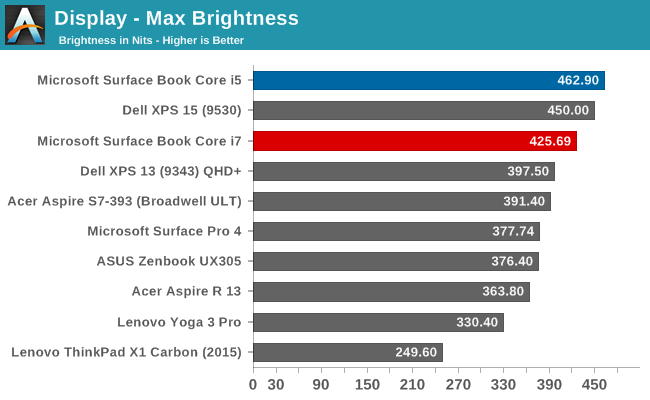
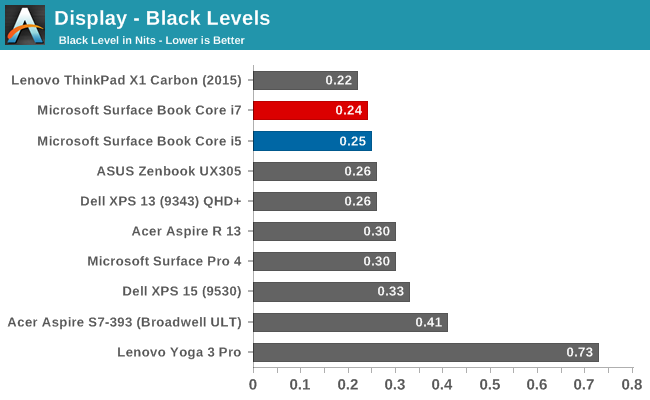
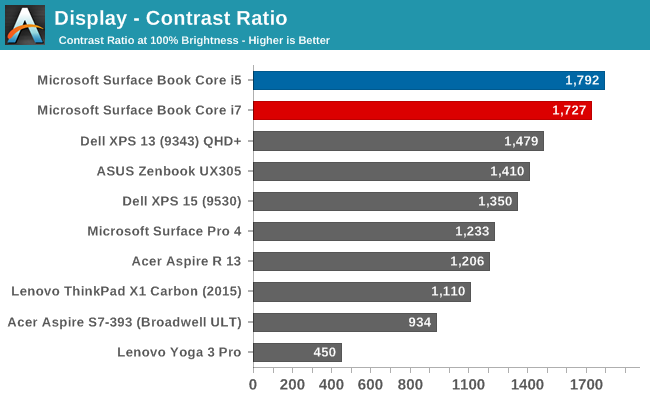
Our first test gets right to the heart of the claim from Microsoft, and sure enough, the Panasonic panel is able to deliver over 1700:1 on contrast. The best part is that the panel has achieved this with amazing black levels, and watching movies on the Surface Book really brings out a lot more detail in dark scenes than most devices are capable of. The brightness is also very good. The Core i5 model that I have has 462 nits of brightness and almost 1800:1 contrast, edging out the Core i7 sample.
Grayscale
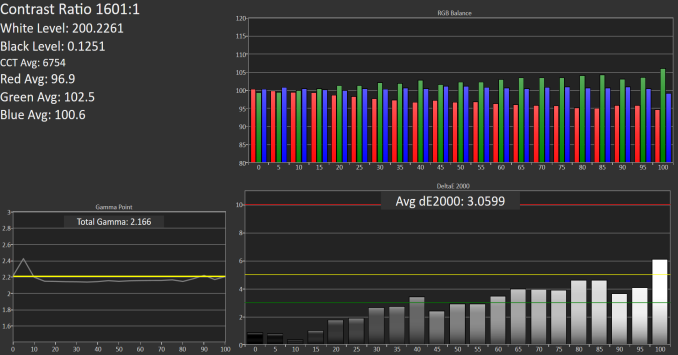 Core i5 Grayscale
Core i5 Grayscale Core i7 Grayscale
Core i7 Grayscale
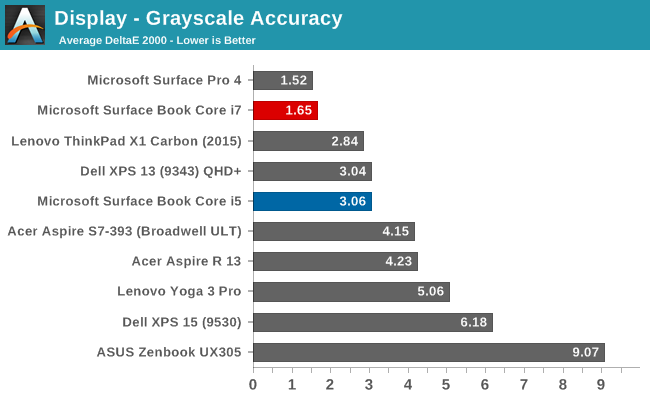
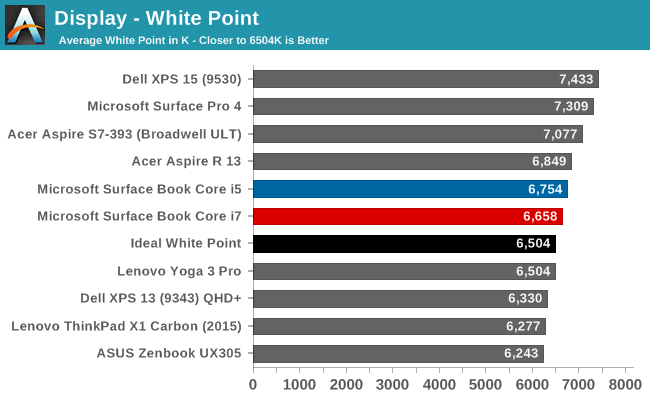
Both models do ok in this test, but the Core i5 model, which was a pre-production sample, had some issues with grayscale, especially as the brightness went up. The Core i7 model, which is a retail sample, seems to be much better here, but with just a sample size of two, it’s difficult to say if this is just luck of the draw. Color temperatures are very close to where they should be as well, and both keep gamma in check which is nice to see.
Saturation
Core i5 (left) Core i7 (right)

Once again, the Core i7 model outperforms the Core i5 pre-production model here, and by quite a bit, although both are well under the limit where you would be able to detect an issue. Both devices can pretty much cover 100% of the sRGB color space.
Gretag Macbeth
Core i5 (left) Core i7 (right)

The most comprehensive test is the Gretag Macbeth, which tests not only the standard sweeps, but also many of the colors in-between, including skin tones. Both models do very well here, with pretty much none of the individual results scoring over 3.0.
Color Comparator
Looking at what all of this means, we can leverage these color comparators, which show the display’s intended color on the bottom, and the actual result on the top. This is a relative comparison, because any inaccuracies in your own display would skew the results.
Core i5 Color Comparator
Core i7 Color Comparator
Both models show very accurate colors, with little differentiation between the top and bottom parts of the images.
Microsoft has promised 100% sRGB coverage as well as individually calibrated panels, and it looks like they have done very well. The Core i7 model in particular, which is a retail sample, has no issues at all with the display accuracy. It’s interesting that they did not go with IGZO technology with the Surface Book like they did with the Surface Pro 4, but the Panasonic panel has amazing contrast, and the backlighting provides great brightness despite the amorphous silicon TFT. The black levels are very good on this display, and accuracy is certainly good enough for almost anyone’s needs. The high accuracy, combined with the high resolution, make the Surface Book one of the nicest displays around, and it’s a pleasure to use.
The days of high DPI being a real issue on Windows is slowly fading away, although there are still plenty of programs that do not play well. It really depends on what exact programs you have, but for most of my workflow high DPI is not a problem at all. Adobe has updated their apps to support higher resolution panels, for example. I’ve been using high DPI Windows PCs for several years now, and although there are still some apps that fall back to DPI virtualization, it’s not been an issue most of the time. If the Universal Windows App platform takes off, this will be well and truly solved, but that has not happened quite yet.


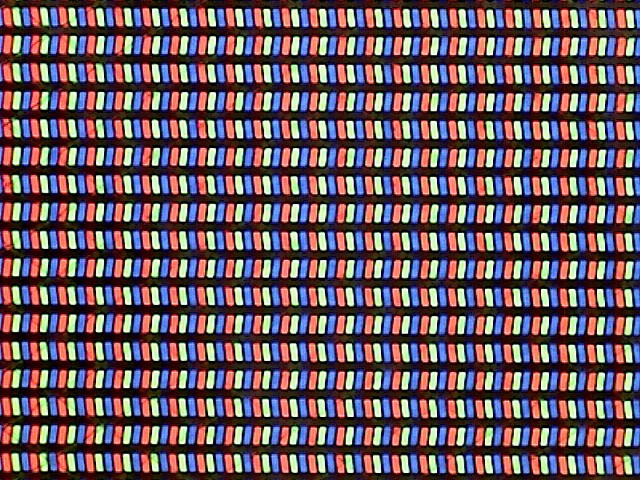
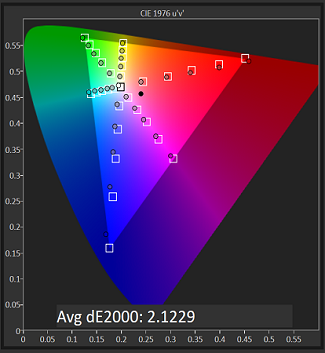
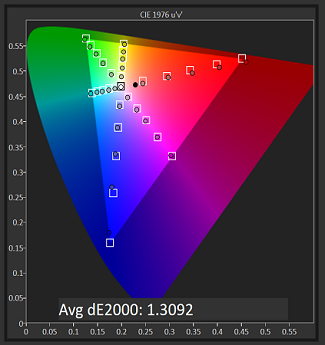

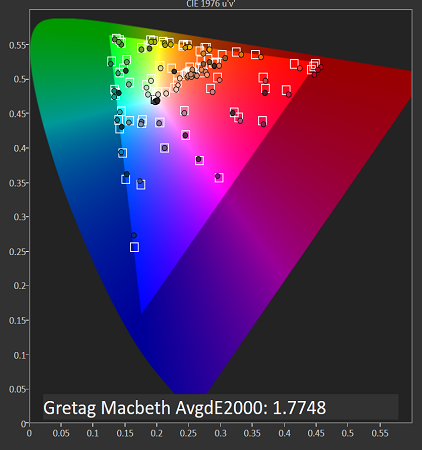












249 Comments
View All Comments
s.yu - Sunday, November 15, 2015 - link
I want to upvote you, Anandtech should add the feature.Vicli - Thursday, November 12, 2015 - link
Whether the surface book PCMark8 work score is improved by its dGPU?how many scores will be improved compared to w/o dGPUeldakka - Thursday, November 12, 2015 - link
The configuration options seem terribly limited. Why can't the SSD options be completely selectable, 128GB-1TB, independent of the amount of RAM or CPU chosen?A 12.1" version (with suitably down-rated components as necessary for the smaller form-factor) with USB-C on the tablet would be tempting if priced right.
s.yu - Sunday, November 15, 2015 - link
I never reckoned this would bother someone. Anyone who only needs 8GB of RAM shouldn't need any more than 256GB of SSD, and anyone who needs 16GB of RAM shouldn't need less than 256GB of SSD, should be the norm.But the real reason should be to prevent people getting 16GB/128GB and swapping out the SSD by themselves ;)
This doesn't seem possible now, but should be possible in the future with more SSD models released, also in "free" markets like China they'll be available on the web when spare parts are abundant.
BrokenCrayons - Friday, November 13, 2015 - link
The problem with the Surface Book's top-heavy tendencies is only partly mitigated by the hinge. We have a couple at work and people who are using them say they're still pretty unstable. I think getting rid of the upper battery and removing the detachment mechanism would have gone a long way in giving the Surface Book better balance. The other problem the hinge design introduces is the gap which means that when the SB is closed, it won't have the benefit of the upper and lower halves of the system acting in a mutually supportive manner to forces accidentally applied to the top or bottom which might result in unintended bending that wouldn't have happened with a better hinge that allows the screen to rest onto the base.I really think Microsoft would have a better product in the second generation if they move all the electronics to the base and deepen it somewhat so the motherboard and battery can all fit. They could also recess the keyboard into the base so the tops of the keys are flush. The screen could be made thinner to make up for some of the extra base thickness and the hinge could be redesigned to remove the flaw of it's big gap that not only demonstrates sloppy design, but also is unappealing to the eye. A good target for Microsoft to model their computer after would be the Latitude e6440 laptop which is a lot more capable, suffers none of the balance problems, and has a very nice keyboard, but I don't think MS would be able to offer it at a competitive price point. The existing SB cost is extremely high for the given hardware and ought to be lower given the flawed hinge and poor design decision with the raised keyboard.
s.yu - Sunday, November 15, 2015 - link
You're absolutely right about those two issues. But since this still is a Surface, MS will have to make it part tablet no matter what, IMO.Instability in the lap is still reported occasionally in reviews, no doubt due to the top-heavy construction, and as I said before, they should use lithium alloy like Lavie Z only in the top portion to deal with this, but some fanboys disagree. Nothing's gonna change the design of their "ultimate laptop"!
One reviewer made the strangest decision to step onto the hinge with the Book open to see if it held. I think he's just a fanboy trying to deceive people into thinking the design is flawless because no force IRL would be applied that way. If he stood on the middle of the *tablet* section, with the Book *closed*, and the tablet section/Surface connectors still didn't snap, that would answer the question.
Total Meltdowner - Friday, November 13, 2015 - link
Slowly but surely, the mutation which is a "tablet computer" is evolving back into a regular laptop. Hilarious.chrisnyc75 - Friday, November 13, 2015 - link
Great review! But I'd like to see it updated with results vs the new Dell XPS 15 (skylake & 960m) rather than last year's Haswell model, at least on the gaming tests if not all of them (though I think it would be an apt comparison point for all of the tests as the XPS 15 is roughly the same size/weight as the Surface Book, and prominently features 4k touch-screen as a primary feature, even if it's not actually a 2-in-1. A lot of people are still going to see the XPS 15 (not just the 13) as a direct alternative to the Surface Book)s.yu - Sunday, November 15, 2015 - link
1. I don't think it supports pen input. Short as the battery life on the clipboard is it's useful for note taking.2.It's still noticably bigger, and...does it still have that big battery option from the old model? Otherwise the battery would be really small.
chrisnyc75 - Sunday, November 15, 2015 - link
All good questions, and exactly why I'd like to see the XPS15 added to the comparison. Sure, the SB detaches, which can be useful, but the very existence of the Surface Book is owed to the fact that tablet sales have been in rapid decline across the market. Putting that bit aside (which I realize is missing the whole point of the Surface Book), they're almost exactly the same size & weight, both ~4k resolution, both touchscreens, & both Skylake + nvidia dgpu. As long as you're only pitting the SB against other detachable devices, it's ALWAYS going to come out on top because MS hit a home run with that part....but does anybody care? Enough to overlook a cheaper option (Surface Pro) or one with more power (XPS)? I personally would like to see the nitty-gritty comparison of the two before I decide.